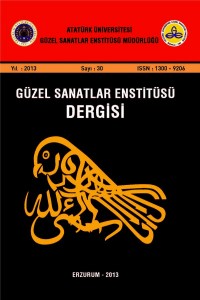Abstract
In this article circular door knockers identified in Rome, Florence, Venice, Naples, San Gimignano, Siena and Lakes Region, Italy are emphasized. Among door knockers which appear to be meticulously protected, this type is predominant. Two main types, particularly circular-circular section and circularrectangular section were identified. Without making any distinction between door knockers and door-rings, mirrors of the types identified were analyzed as well. There are plain and ornamental types of circular door knockers. Acanthus leaves, C curves and floral motifs are remarkable especially in ornamental types. In this group of door knockers, generally brass, bronze and iron were used as in the other types of door knockers in Italy.
Keywords
References
- Ataoğuz Çal, Ö. (2004). “Kastamonu Şehri Kapı Halkaları ve Tokmakları” Gazi Üniversitesi Kastamonu Eğitim Dergisi C.12, S.2 Kastamonu, 485-50
- Ataoğuz Çal, Ö.(2008). “Ali Bey Adası (Ayvalık) Kapı Halkaları ve Tokmakları” Erciyes Üniversitesi Sosyal Bilimler Enstitüsü Dergisi S.25, Yıl: 2008/2, Kayseri, 225-240.
- Çal, H. - Çal, Ö.(2008). Trakya Bölgesi Kapı Tokmakları ve Çekecekleri, Ankara.
- Çal, H.(1999). “Afyon Şehrinin Kapı Tokmakları”, Vakıf ve Kültür, C. 2, S.6, Ankara, 50–53.
- Çal, H.(1999). “Osmanlı Kapı Halkaları ve Kapı Tokmakları”, Osmanlı, C. 11, Ankara, 275-284.
- Çal, H.(2001). “Hatay Kapı Halkaları Ve Tokmakları”, Ortadoğu’da Osmanlı Dönemi Kültür İzleri Uluslar Arası Bilgi Şöleni Bildirileri, 1. C, Ankara, 173–188.
- Denktaş, M.(2005). “Divriği’nin Kapı Tokmakları ve Kapı Halkaları” Erciyes Üniversitesi Sosyal Bilimler Enstitüsü Dergisi, 2005/2, S.19, Kayseri, 113-1
- Köşklü, Z.(2006). “ Eski Erzurum Evlerinde Kapı Tokmakları” IX. Ortaçağ ve Türk Dönemi Kazıları ve Sanat Tarihi Araştırmaları Sempozyumu 21-23 Nisan 2005 Bildiriler, Erzurum, 337-346.
- Köşklü, Z.(2012). “İtalya Örnekleriyle Aslan Başlı Kapı Tokmakları” Güzel Sanatlar Enstitüsü Dergisi, Yıl:2012, S.28, Erzurum, 119-133. Özme, A.-Şahin, H.( 2001). “Geleneksel Malatya Evlerinde Cümle Kapıları” Türk Arkeoloji ve Etnoğrafya Dergisi, S.2, Ankara, 123-128.
Abstract
Bu makalede İtalya’da Roma, Floransa, Venedik, Napoli, San
Gimignano, Siena ve Göller Bölgesi’nde tespit ettiğimiz daire biçimli kapı
tokmakları üzerinde durulmuştur. Özenle korunduğu anlaşılan kapı
tokmakları içerisinde büyük bir yoğunluğu bu tip oluşturmaktadır. Daire
biçimli-yuvarlak kesitli- ve daire biçimli -dikdörtgen kesitli- olmak üzere iki
ana tip belirlenmiştir. Kapı halkaları ve tokmakları ayırımına gidilmeden
tespit edilen örneklerin ayrıca aynaları da incelenmiştir. Daire biçimli
tokmaklarda bezemesiz ve bezemeli örnekler bulunmaktadır. Özellikle
bezemede akant yaprakları, C kıvrımları ve çiçek motifleri dikkat çekicidir.
İtalya’da diğer kapı tokmaklarında olduğu gibi bu grubu oluşturan
tokmaklarda da pirinç, bronz ve demir kullanılmıştır.
Keywords
References
- Ataoğuz Çal, Ö. (2004). “Kastamonu Şehri Kapı Halkaları ve Tokmakları” Gazi Üniversitesi Kastamonu Eğitim Dergisi C.12, S.2 Kastamonu, 485-50
- Ataoğuz Çal, Ö.(2008). “Ali Bey Adası (Ayvalık) Kapı Halkaları ve Tokmakları” Erciyes Üniversitesi Sosyal Bilimler Enstitüsü Dergisi S.25, Yıl: 2008/2, Kayseri, 225-240.
- Çal, H. - Çal, Ö.(2008). Trakya Bölgesi Kapı Tokmakları ve Çekecekleri, Ankara.
- Çal, H.(1999). “Afyon Şehrinin Kapı Tokmakları”, Vakıf ve Kültür, C. 2, S.6, Ankara, 50–53.
- Çal, H.(1999). “Osmanlı Kapı Halkaları ve Kapı Tokmakları”, Osmanlı, C. 11, Ankara, 275-284.
- Çal, H.(2001). “Hatay Kapı Halkaları Ve Tokmakları”, Ortadoğu’da Osmanlı Dönemi Kültür İzleri Uluslar Arası Bilgi Şöleni Bildirileri, 1. C, Ankara, 173–188.
- Denktaş, M.(2005). “Divriği’nin Kapı Tokmakları ve Kapı Halkaları” Erciyes Üniversitesi Sosyal Bilimler Enstitüsü Dergisi, 2005/2, S.19, Kayseri, 113-1
- Köşklü, Z.(2006). “ Eski Erzurum Evlerinde Kapı Tokmakları” IX. Ortaçağ ve Türk Dönemi Kazıları ve Sanat Tarihi Araştırmaları Sempozyumu 21-23 Nisan 2005 Bildiriler, Erzurum, 337-346.
- Köşklü, Z.(2012). “İtalya Örnekleriyle Aslan Başlı Kapı Tokmakları” Güzel Sanatlar Enstitüsü Dergisi, Yıl:2012, S.28, Erzurum, 119-133. Özme, A.-Şahin, H.( 2001). “Geleneksel Malatya Evlerinde Cümle Kapıları” Türk Arkeoloji ve Etnoğrafya Dergisi, S.2, Ankara, 123-128.
Details
| Primary Language | tr;en |
|---|---|
| Journal Section | Articles |
| Authors | |
| Publication Date | November 19, 2013 |
| Submission Date | November 19, 2013 |
| Published in Issue | Year 2013 Issue: 30 |
Obtaining permissions for studies requiring ethics committee approval regarding the implementation of ethical rules and including information about permission in the article was added to the criteria. In this direction, Ethics Committee Permission is required for articles submitted to our journal and meeting the conditions stated below.
• Any research conducted with qualitative or quantitative approaches that require data collection from participants using questionnaires, interviews, focus group work, observation, experimentation, and interview techniques.
Also;
• Obtaining and indicating permission from the owners for the use of scales, surveys and photographs belonging to others,
• It should be stated that the copyright regulations are complied with for the intellectual and artistic works used.


